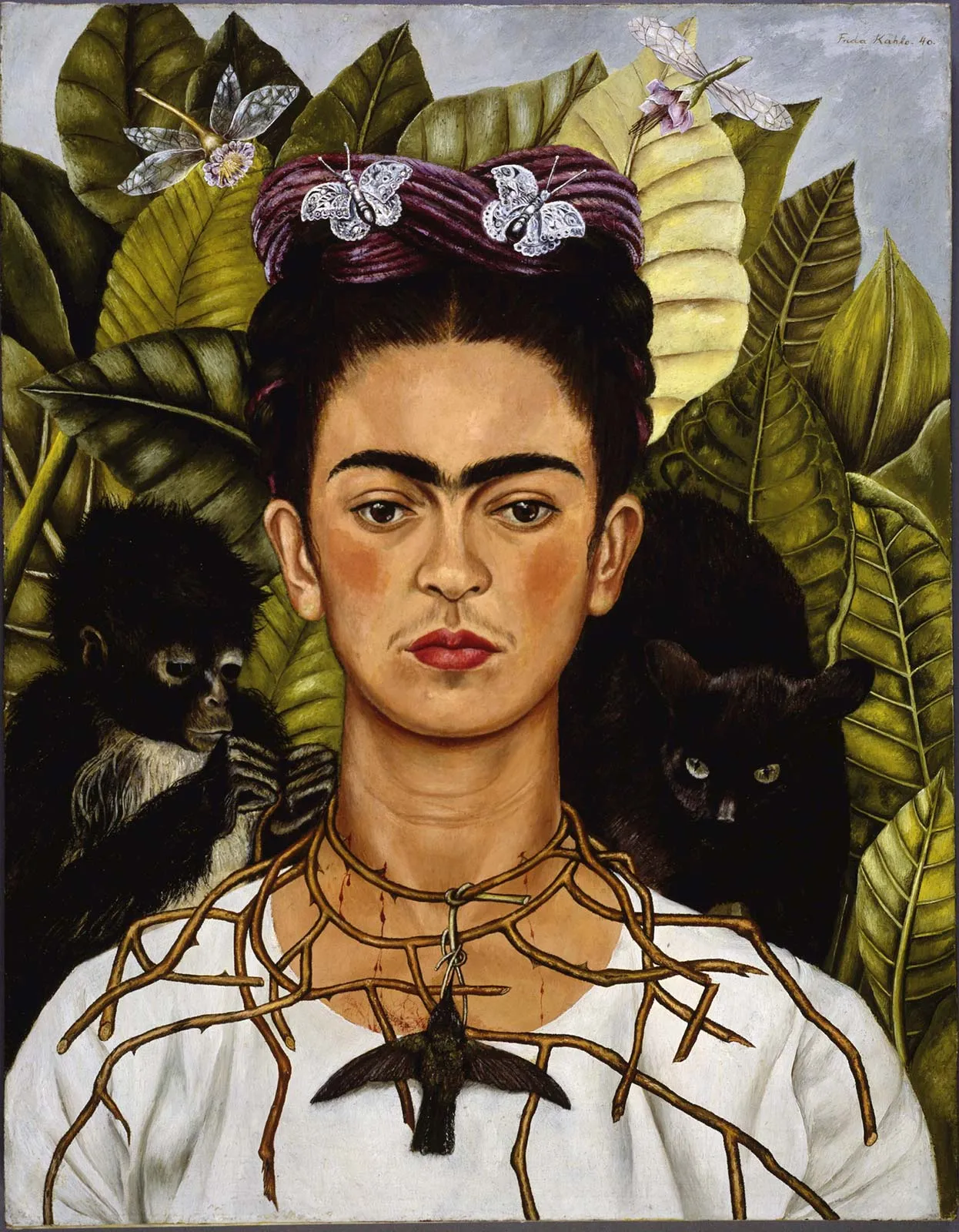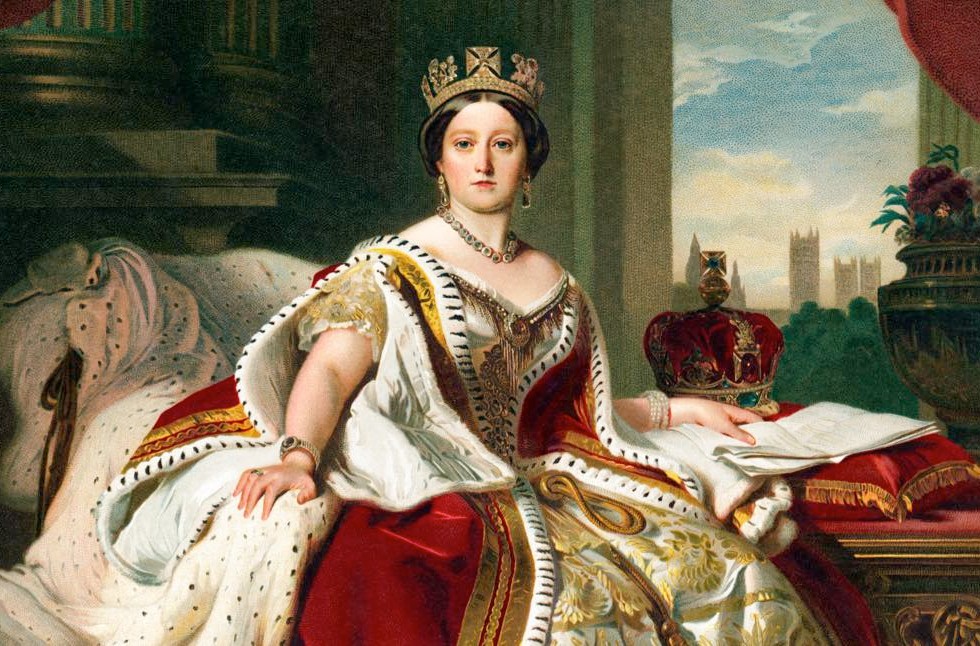
An illustration of Julia Pastrana, a Victorian stage performer who toured Europe, Canada, and the United States billed as the Bearded or Hairy Lady, the Nondescript, the Ape-Woman, the Marvelous Hybrid or Bear Woman.
Julia Pastrana (1834-1860) was one of the most famous human curiosities of her time, touring Europe, Canada, and the United States in the 1850s as “the Bearded Lady” or the “Ape-Woman.” Born poor in Mexico, she suffered from a rare inherited disorder (hypertrichosis), not understood during the Victorian Age, that caused her entire body to be covered in silky, black hair. Add to that a jutting jaw with huge teeth that made her look positively like a monkey. Yet while grotesque and freakish, she also exuded a feminine grace. She sang Spanish songs sweetly, had slender feet and hands, and displayed a buxom figure at a petite four-and-a-half feet tall. She styled her hair in elaborate coiffures and wore embroidered lace dresses that barely covered her knees. She spoke three languages, cooked, and sewed. In her stage act, she danced a Highland Fling.
When she toured London in 1857 in one of the monster shows popular at the time, she attracted journalists, doctors, and scientific minds. Julia was very popular. It cost 3 shillings to see her in the Regent Gallery, compared to the 6 shillings that a Victorian laborer might earn in a week. Promoted by her avarious manager and new husband, Theodore Lent, Julia was now billed as “The Nondescript,” suggesting that she was a unique species, perhaps “the missing link” between humans and the rest of the animal kingdom. Debate raged in the newspapers as to her origins and her appearance was described at length. She submitted to medical examinations freely and received many distinguished visitors. Charles Darwin mentioned her in his book, The Variation of Animal and Plants under Domestication, writing:
Julia Pastrana, a Spanish dancer, was a remarkably fine woman – she had a thick and masculine beard.”
Julia loved her husband very much and, in 1859 in Moscow, she became pregnant with their first child. Her doctors were worried. Julia’s narrow hips and small frame could mean a difficult childbirth, they warned. On March 20, 1860, Julia gave birth to a hair-covered little boy. He died within 35 hours. Julia died five days later, at age 26.
Theodore Lent was distraught. Julia had been the bank. Now the bank was closed! How was he to live now that his source of income had died? He had a Eureka moment. Why should the bank close? He sent Julia’s corpse and that of his newborn son to Professor Sukolov of Moscow University for embalming. The process took 6 months but the results were amazing. Julia’s mummified remains looked lifelike. He dressed Julia in one of her dancing costumes and his son in a cute sailor suit. He stood them up on a pedestal and took them on a tour, exhibiting them as pickled specimens for 20 years.

Julia Pastrana and son, embalmed, on tour after their deaths
When touring Sweden, Theodore met another hairy young woman named Zenora who suffered from a condition very similar to Julia. He married her and began touring her as Zenora Pastrana – Julia’s sister. Theodore grew richer and richer. In the 1880s, he and Zenora retired to St. Petersburg where they bought a waxworks museum. Theodore wasn’t able to enjoy his retirement for long because he became ill and was sent to a lunatic asylum where he died.
Over the course of the next 100 years, the mummies changed hands countless times, being sold to German fairs, an Austrian circus, and a Norwegian chamber of horrors. They came out of mothballs in 1970 and went on a short tour of Sweden and Norway. An American tour was aborted due to public outcry over the utter tastlessness of the idea. The mummies were put in storage by Norwegian owner Hans Lund in 1973.
In August of 1976, vandals broke into the storage unit. Julia’s mummified son was mutilated and his remains eaten by mice. Only her body remained. Then in 1979, the storage facility was again broken into and Julia’s body was stolen. It was assumed at the time to be destroyed.
Then, in February of 1990, a Norwegian journalist made a surprise discovery of a mummy in the basement of the Institute of Forensic Medicine in Oslo. It turns out that, back in 1979, the police had responded to a call involving some children who found an arm in a ditch. A search revealed the mummified body of Julia, badly mangled. The police did not know her identity. They took the mummy to the Institute.
It is believed by some, though not confirmed by me at this time, that the remains of Julia Pastrana have rested in a sealed coffin at the Department of Anatomy at Oslo University since 1997. “She is now a buried woman, not an exhibition object. She rests [at peace],” says Professor Gunnar Nicolaysen [translated from Norwegian].



















It doesn’t surprise me that someone like Theodore who could get rich off other people that way, would end up in a lunatic asylum. Everything comes full circle.
Jennifer
LikeLike
I have read but not documented that in Theodore’s last days before commitment, he ran around a bridge throwing money off it. He evidently lost his sanity.
LikeLike
The story under this link (looks like fiction) contains unexpected historical facts behind Dostoevsky’s novel “Idiot” (”PROTOTYPE OF PRINCE MYSHKIN”)
You can found JULIA PASTRANA from this story, she were in Russia 1850->
http://www.netmox.net/main.php?siirry=27&sivulle1=Go –
LikeLike
Hi, Gregory, on what page is the reference to Julia Pastrana?
LikeLike
Dear Lisa,
Page 6,
(pace 30 too, but in finnish only)
GL
LikeLike
“Ivan Painov: And old drunks, new drunks, sycophants, rogues! And even freaks of nature, like Julia Pastrana, “the world’s ugliest woman.”
mox the Recorder: Julia Pastrana’s story is moving and ghastly; her embalmed body traveled the world in a freak show until the 1970’s, and the American movie industry is currently cooking something up about her… but that’s a completely different story. Grishka, continue your tale. ”
Thanks, Gregory. When was this written?
LikeLike
Hi,
The script was written probably 1995-2005.
GL
LikeLike
Thanks.
LikeLike
Hi,
Does anyone know if the movie about Julia Pastrana’s life is still in development? It was called “Fortune of Love” and Sobini Films, Permut Presentations, and Richard Gere Productions were going to make it. Sobini has since dropped out and I can’t find any information about it. I have published a historical fiction novel about her life and am searching for information on the movie. Does anyone have any idea? Thanks.
LikeLike
[…] 624. Tag Julia Pastrana Veröffentlicht am April 21, 2010 von auraleserin Ein Link führte mich zu einem anderen Blog auf WordPress. Dort fand ich einen Artikel in Englisch zu Julia Pastrana (1834-1860) , einer Frau mit sehr starker Körperbehaarung, die um 1850 in Amerika als bärtige Frau herumreiste. Der Text ist leider auf Englisch, ich werde ihn demnächst übersetzt ins Deutsche hier reinstellen. Für alle die Englisch gut verstehen hier der Link. […]
LikeLike
In Wikipedia they say that they did not want to make the film anymore…..
LikeLike
I heard some murmurs about a film in the fall of 2009 but then nothing came of it.
LikeLike
They are no longer making the film. Everyone dropped out. I believe Sobini Films or Permut Presentations has it on the back burner but there are no near future plans to do anything with it. It’s too bad, it would have made an amazing movie.
LikeLike
Thanks for the update, Sandra. What a sad story it is.
LikeLike
Hi!
According to this artcle in a Norwegian newspaper Juliana is in “Anatomisk institutt på Rikshospitalet”. That is the medical faculty of Oslo Univerisity. In the 1990´s the Norwegian government appointed a comittee to decide whether she should be burried in Mexico or to stay in Norway. She is now sealed down, but not burried in the ground.
http://www.dagbladet.no/kultur/2001/03/18/247966.html
LikeLike
If you ask me the true “freak” in this case was that avaricious husband. It’s clear to me he didn’t love her at all. Poor Julia.
LikeLike
I am in possession of two photos, one of Julia in her shipping crate, and the other of the advertising banner that traveled with her. The front of the crate has been removed to allow inspection by Customs Officers at the Port of Baltimore, and they were both taken in 1972. Let me know if you are interested. They are previously unpublished.
LikeLike
Wow. That is amazing.
LikeLike
[…] – Lisa’s History Room, 5 & 7 – Sideshow Ephemera […]
LikeLike
Mexican ‘ape woman’ buried after 150 years
By MARTIN DURAN and MICHAEL WEISSENSTEIN | Associated Press
SINALOA DE LEYVA, Mexico (AP) — An indigenous Mexican woman put on display in Victorian-era Europe because of a rare genetic condition that covered her face in thick hair was buried in her home state on Tuesday in a ceremony that ends one of the best-known episodes from an era when human bodies were treated as collectible specimens.
With her hairy face and body, jutting jaw and other deformities, Julia Pastrana became known as the “ape woman” after she left the Pacific coast state of Sinaloa in 1854, when she was 20, and was taken around the United States by showman Theodore Lent, according to a Norwegian commission that studied her case.
She sang and danced for paying audiences, becoming a sensation who also toured Europe and Russia. She and Lent married and had a son, but she developed a fever related to complications from childbirth, and died along with her baby in 1860 in Moscow. Her remains ended up at the University of Oslo, Norway. After government and private requests to return her body, the university shipped her remains to the state of Sinaloa, where they were laid to rest.
“Julia Pastrana has come home,” said Saul Rubio Ayala, mayor of her hometown of Sinaloa de Leyva. “Julia has been reborn among us. Let us never see another woman be turned into an object of commerce.”
After a Roman Catholic Mass in a local church, Pastrana’s coffin was carried to the town cemetery and buried as a band played traditional music.
“The story is so important,” said visual artist Laura Anderson Barbata, who campaigned for Pastrana’s return to Sinaloa. “Bringing her back here is a way of recovering it.”
Pastrana’s repatriation is part of a broader movement among museums and academic institutions to send human remains gathered during the European colonization of Latin America, Africa and Asia back to their countries and tribal lands.
Hundreds of thousands of remains have left cultural institutions in the U.S., Europe and Australia since the repatriation movement began in the late 1980s, when a new generation of anthropologists, archeologists curators began grappling with the colonial legacies of their disciplines, said Tiffany Jenkins, author of “Contesting Human Remains in Museum Collections: the crisis of cultural authority.”
“They’ve been symbolic, in a way, of making an apology,” Jenkins said.
Institutions in Scandinavian countries have come to the movement somewhat later than their counterparts in other parts of Europe and in the United States, where more than a half-million sets of remains and artifacts have been returned to Native American tribes, she said.
“Norway has become in recent times more uncomfortable about their holding of human remains,” she said.
Mexican Ambassador Martha Barcena Coqui, who is based in Copenhagen, Denmark, formally received Pastrana’s coffin at a Feb. 7 ceremony at Oslo University Hospital in the Norwegian capital before the coffin was flown to Mexico.
“You know I have mixed feelings,” the ambassador said. “In one way, I think she had a very interesting life and maybe she enjoyed visiting and traveling and seeing all the places, but at the same time I think it must have been very sad to travel to these places not as a normal human being but as a matter of exhibition, as something weird to be talked about.”
Jan G. Bjaalie, head of the Institute of Basic Medical Sciences at the University of Oslo, said he was happy that they had “finally been able to grant a worthy end to her life.”
“Today, it’s almost incomprehensible that a circus used corpses for entertainment purposes. Hers was used in a way we today would consider to be completely reprehensible,” he said. “It’s important that we now have a clear end to the way she was treated.”
LikeLike
The ”Bearded Lady” is now in her motherland,Mexico…..R.I.P.
LikeLike
What happened to Zenora Pastrana?
LikeLike
I’m not that much of a online reader to be honest but your blogs really nice, keep it up!
I’ll go ahead and bookmark your website to come back later. Cheers
LikeLike
Good news! Now, Julia Pastrana is back in Mexico and buried.
LikeLike
Sorry I forgot to include the link: “World’s ‘ugliest woman’ Julia Pastrana buried 153 years on” http://www.bbc.co.uk/news/world-latin-america-21440400
LikeLike
In the article Jim posted, it is said that today it is not thinkable that people are exhibitied and being made fun of as it was at that time. As far as I understand the article. But lets think of all the TV Shows, as Big Brother and many more, where people are watched in order to laugh about them and to point with the finger at them. Yes it is more distant it is in the TV, but when these people are in the street, others will talk about them badly, Magazines write badly about them…..so humanity is still at the same point of needing others that they can talk bad about in order to feel good themselves.
LikeLike
I like the valuable information you supply in your articles.
I’ll bookmark your blog and test once more right here frequently.
I’m quite sure I will be informed a lot of new stuff proper here!
Good luck for the following!
LikeLike
Hattie, see you again on Lisa’s History Room! Best, Lisa
LikeLike
thanks for such an informative blog! how wonderful to hear that this lovely woman was finally lain to rest after 150 yrs! does anyone know if her remains were ever displayed in the 1970s in america? maybe at a ripley’s museum? i have a vague childhood memory from 40 to 50 yrs ago, maybe it was a wax replica somewhere? thanks, char
LikeLike
Glad her husband went crazy and died he was cursed as was those others who possessed her mummified remains…she should of been buried not exhibited now she can rest in peace sad for her son but his remains should of been with her…sad they never had better doctors to help with birthing in those days RIP Julia and Son God bless you in the afterlife my prayers are with you both…
LikeLike